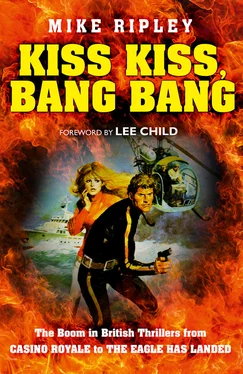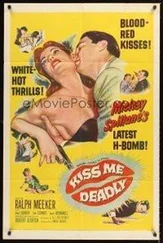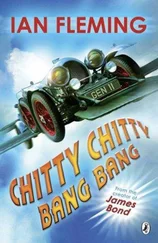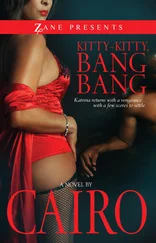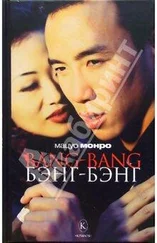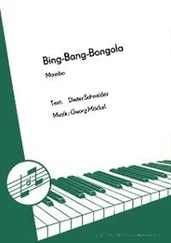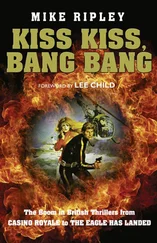1 ...8 9 10 12 13 14 ...19 The Second World War continued to kick-start thriller writers into taking up their typewriters for at least a quarter of a century after it formally ended. Brian Callison started his lengthy thriller-writing career with A Flock of Ships in 1970 (of which Alistair MacLean said: ‘The best war story I have ever read’) 5and in 1974 George Markstein moved from television to novel writing with The Cooler , set in England on the eve of D-Day.
For other writers, it may not have provided the initial impetus, but it certainly led to a breakthrough in terms of sales and a quantum leap in reputation for authors such as Colin Forbes ( Tramp in Armour in 1969), Jack Higgins ( The Eagle Has Landed , 1975, which was in fact his thirty-sixth thriller and certainly not his first wartime setting), and Ken Follett ( Eye of the Needle , 1978).
In a way the template had been created during WWII itself and very early on as well. Hammond Innes, who was to enjoy huge success in the Fifties, had published four novels before the war, but it was his three war stories – Wreckers Must Breathe , The Trojan Horse (both 1940), and Attack Alarm (1941) – which were to lay the foundations of his post-war bestselling career. Three excellent thrillers in less than two years is an impressive enough feat for anyone, let alone someone serving as an anti-aircraft gunner during an actual war. The imaginative and, no doubt at the time, sensational, if not terrifying Wreckers Must Breathe , about a secret U-boat base in the coastal caves and tin mine workings of Cornwall, was supposedly written as a result of a holiday in Cornwall by Innes and his wife in the late summer of 1939. Both The Trojan Horse and Attack Alarm would have been thrillingly ‘topical’ to the British reading public now at war and although Innes – serving in the Royal Artillery – did not resume fiction writing until 1946, his reputation as a storyteller survived and his readership was waiting for him.
The damage and displacement left by the Second World War remained a central theme in British thrillers, its main legacy of course being the Nazis, the best fictional villains no writer ever had to invent. The swastika became a vital part of the tool-kit of every book jacket designer and no bookshop or library shelf was immune. Thirty years after the actual fall of the Third Reich, in 1975, British humourist Alan Coren published a collection of his funniest essays from Punch magazine under the title Golfing for Cats , having noted that as books about cats and golf sold well, this seemed as good a title as any. But Coren had also noticed how many bestsellers featured swastikas on their covers and so insisted that his publisher include one! The paperback cover showed a cat on a golf course where the pins marking the greens flew swastika flags. 6
The European war against the Nazis and its aftermath formed, if not the setting, then the back story or main plot point to a seemingly inexhaustible supply of thrillers. Nazi war criminals, neo-Nazis, resurgent Nazis, Nazi secrets and secret weapons, works of art stolen by Nazis, missing Nazi submarines, and (very popular) hoards of Nazi gold, sometimes on board the missing submarines, were all grist to the thriller mill.
The first three ‘Johnny Fedora’ novels by Desmond Cory – Secret Ministry (1951), This Traitor, Death (1952), and Dead Man Falling (1953) – all had Nazis or Nazis-on-the-run as villains. In a later adventure, Undertow (1962), Fedora is involved in salvaging secret Nazi documents (before his Russian KGB opponents can get them) from a sunken submarine off the southern coast of Spain. James Bond himself had to tackle a megalomaniac Nazi bent on attacking London with an upgraded V-2 rocket in the form of Sir Hugo Drax in Moonraker in 1955, only a decade after the real thing. 7In 1958, John Blackburn’s A Sour Apple Tree suggested an evil legacy put in place by a William Joyce-like character, an English traitor who had made radio broadcasts for the Nazis (and escaped in a U-boat). Geoffrey Jenkins’ 1959 debut A Twist of Sand revolved around the wartime destruction of a top-secret U-boat off Namibia’s Skeleton Coast. In Watcher in the Shadows (1960), Geoffrey Household had his hero, who is mistaken for a Nazi war criminal, being hunted across the idyllic English countryside by a vengeful former leader of the French Resistance. 8Geoffrey Household being Geoffrey Household, and the author of the classic pre-war thriller Rogue Male , the result is something akin to the gunfight at the O.K. Corral being staged in St Mary Mead. In 1961, under the pen-name Martin Fallon, an early Jack Higgins thriller called The Testament of Caspar Schultz revolved around the hunt for authentic missing Nazis and in 1962, Philip Purser’s debut thriller Peregrination 22 exposed a neo-Nazi youth movement being secretly trained on the Arctic island of Spitsbergen.

Secret Ministry , Frederick Muller, 1951

Horse Under Water , Penguin, 1965
Neither could the ‘new wave’ of spy-fiction writers in the Sixties resist the hypnotic glow of the Nazis. Len Deighton’s Horse Under Water (1963) had his un-named spy hero scuba-diving for secrets into a wrecked U-boat off the Portuguese coast; Adam Hall’s super-agent, the seemingly indestructible Quiller, single-handedly disabled a Nazi resurgence in The Berlin Memorandum in 1965; James Leasor’s Bond clone, Dr Jason Love, faced a megalomaniac ex-Nazi (armed with a fleet of U-boats) in Passport in Suspense in 1967; Lionel Davidson gave us a much more measured, less frantic, thriller about claiming reparations for Nazi crimes in modern Germany in Making Good Again in 1968; Reg Gadney’s Somewhere in England (1971) had wanted Nazis alive and well and living in the UK; and, possibly the most famous of all, in The Odessa File in 1972, Frederick Forsyth had them alive, well and very active just about everywhere.
The appeal of the Nazis for fictional purposes was fairly obvious. As far as the British were concerned they represented a force of pure evil which seemed to blend barbarism and paganism, even the occult, with modern technology and perverted science and medicine, truly heralding a new Dark Age for Europe if not the world, as Winston Churchill had warned. They were easily identified and immediately sinister. In Hollywood Westerns, the bad guys traditionally wore black hats; the worst of the Nazis, the SS, conveniently wore black uniforms. Even their so-called secret police, the Gestapo, had an iconic fashion sense, with black leather trench coats and soft black Fedoras which made them instantly recognisable to millions of cinemagoers. As villains went they were, thanks to Hugo Boss, tailor-made.

Passport in Suspense , Pan, 1969

The Achilles Affair , Fontana, 1961
Nazism had seen murder on an industrial scale; robbery and theft from individuals, the pillaging and piracy of entire countries; education, art, medicine, the media, and history twisted to a bizarre ideology. And it had been done with all the accoutrements that twentieth-century technology could provide.
Читать дальше
